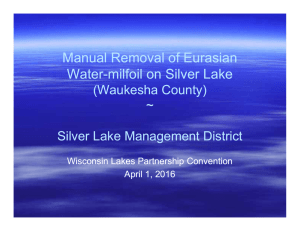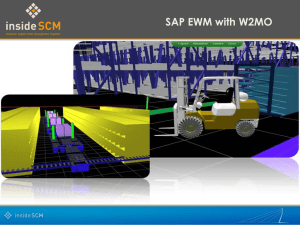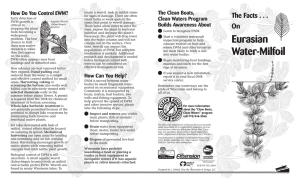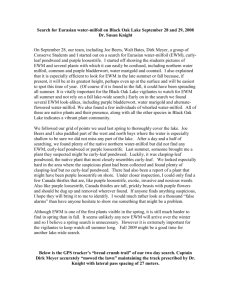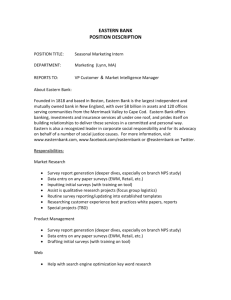Economic Damages from Ecosystem Shocks: Evidence from Aquatic Species Invasions David J. Lewis
advertisement
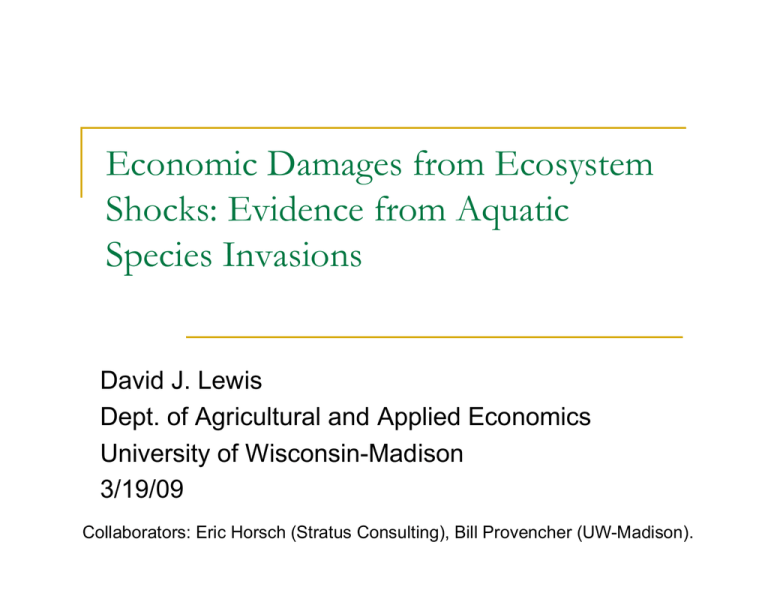
Economic Damages from Ecosystem Shocks: Evidence from Aquatic Species Invasions David J. Lewis Dept. of Agricultural and Applied Economics University of Wisconsin-Madison 3/19/09 Collaborators: Eric Horsch (Stratus Consulting), Bill Provencher (UW-Madison). Aquatic invasive species Invasive species are widely believed to have a large impact on ecosystem services. From a research perspective, an invasion serves as a natural experiment of an ecosystem change. Examples that humans will perceive. Minimal research on quantifying the economic damages from invasive species. U.S. spends an estimated $120 billion per year on invasive species (Pimentel et al. 2005). The Issue Q: what is the effect of an aquatic species invasion – an ecosystem shock – on quantitative welfare measures for those who use lakes? Two possible approaches: Hedonic analysis: how do species invasions become capitalized into land values? Contingent valuation: what is the average shoreline landowner’s willingness-to-pay to prevent invasions? Hedonic Pricing Models – Housing Market What determines the value of a house? Site characteristics: lot size, shoreline frontage, number of bedrooms, age of house, etc. Neighborhood characteristics: distance from downtown, quality of schools, etc. Environmental characteristics: noise levels, air quality, scenic views, proximity to dis-amenities (e.g. landfills), etc. Using data on property transactions, statistical analysis is used to decompose the price effects of each attribute. Hedonic Pricing Models – Housing Market Competitive land markets ensure that property attributes are capitalized into land values. Prices are bid up for properties with desirable attributes. Prices are bid down for properties with undesirable attributes. Examples from prior research: Air and water quality School quality If AIS are truly undesirable, then property prices on AIS lakes should be bid down relative to prices on non-AIS lakes. The application Lakeshore property owners in Vilas County, WI. Over 170 lakes within Vilas County. Eurasian watermilfoil (EWM) invasions. A non-native plant. 10% of lakes affected. 21% of recent property transactions on EWM lakes. The application Eurasian watermilfoil (EWM) Effects of EWM: Blocks sunlight and competes with native plants. Inhibits predator-prey relationships with fish. Limits human recreation. Quasi-irreversible once established. Uncertainty of effects: Can rapidly cover a water body. Sometimes it has minimal effects. Difficult to predict which lakes will be most affected. Eurasian watermilfoil (EWM) EWM is a widespread problem for freshwater systems. As with other aquatic invasive species, EWM’s spread is often by humans. Boats Trailers Bait Buckets Motors The hedonic application Arms-length shoreline property transactions (1997-2006): 1,841 sales. Available data: Structural: assessed structural values. Parcel characteristics: shoreline frontage, lot size. Lake characteristics: lake size, water clarity, distance to nearest town, shoreline development density, zoning, boat launch, lake association, fishing quality. EWM measures: Presence/absence and year of invasion. DNR surveys of lake-wide relative abundance (available for ’05, ’06 only). Data sources: WI Bureau of Revenue, Vilas Co. Info. Tech. Dept., Vilas Co. Mapping Dept., Wisconsin DNR, Env. Remote Sensing Center at UW-Madison, Local Fishing Guidebooks. The hedonic application Looking at the raw data, properties on lakes with EWM tend to sell for more than properties on lakes without EWM. EWM lakes tend to be larger and have more sport fish such as Musky and Walleye. EWM is more likely to spread to lakes that are popular with boaters; these lakes are also popular with homeowners. Intuition on statistical (econometric) model • The time of invasion is a $ “natural experiment”. • We estimate a lake-specific premium (P) for every lake that captures all features of a lake that don’t change over time: lake size, scenery, etc. PEWM PNo EWM • The lake-specific premium is allowed to vary over time and we test for the effects of the time of invasion. tM tM: year of EWM invasion. : drop in price due to invasion. time •Attributes specific to the property (e.g. lot size, frontage, etc.) are separately controlled for. Hedonic Results (1997-2006) Before EWM Linear Fixed Effects Non-Linear Fixed Effects Estimate Robust Std. Err. Estimate Robust Std. Err. $28,294* 9509 $32,087* 14135 Results indicate that properties on EWM lakes sold for approx. $30,000 more per property before being invaded. This is approximately 8% of the average property value, or 13% of the average value of land net of structural values. In annual terms, the average homeowner is willing-to-pay approximately $1,400** to prevent an invasion of their lake by EWM. Single asterisk (*) denotes significance at the 95% level. All standard errors are clustered by lake. ** Assumes a 5% discount rate. Contingent valuation – An alternative to hedonic modeling Contingent valuation (CV) – ask people directly their WTP to prevent environmental damage. Exploits the experimental control of a survey. Common criticism: ask a hypothetical question, get a hypothetical answer. Evidence shows CV does particularly well for goods that provide familiar use values (Carson et al. 2001). People are well aware of EWM. We are attempting to verify the hedonic estimates for EWM with a CV study – this work is on-going and not yet complete. 2008 UW-Madison Survey of Vilas County Lakeshore Landowners Survey sent to approx. 3000 shoreline property owners. 92% of respondents were familiar with EWM invasions before receiving the survey. Many respondents expect EWM invasions within 10 years. Many respondents claim EWM is at least “somewhat of a problem” on their lake. Conclusions Aquatic invasive species can yield significant economic damages. Eurasian watermilfoil invasion lowers lakefront land values by approximately 13%. Average annual loss for an additional invaded lake is approx. $187,000. On-going survey work aims to check the property value estimates with alternative methods. More information Property value citation: Horsch, E.J., and D.J. Lewis. 2009. “The Effects of Aquatic Invasive Species on Property Values: Evidence from a QuasiRandom Experiment.” Land Economics (In Press). Copy available as a staff paper at the following website: http://www.aae.wisc.edu/pubs/sps/. Survey results of Vilas County shoreline property owners available at the following website : http://lter.limnology.wisc.edu/. 2005 survey results available. 2008 survey results will be available by end of summer. UW-Madison environmental economics researchers David Lewis: dlewis2@wisc.edu Bill Provencher: rwproven@wisc.edu
